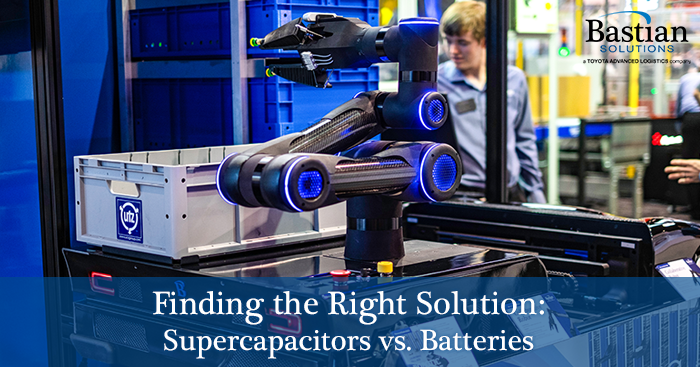
Finding the Right Solution: Supercapacitors vs. Batteries
Tiffany Greyson | 28 August 2019
Often enough, seemingly straightforward choices can have unexpected consequences. When choosing between alternatives, it’s typical to consider the benefits of each option – but rarely the consequences of what would happen if something goes catastrophically wrong.
Earlier this year, Ocado, ‘the world's largest dedicated online grocery retailer,’ had a massive warehouse fire. The fire spread to the entire warehouse and cost Ocado $137 million dollars. Neighborhoods around the south England facility had to be evacuated due to the explosion hazard of some warehouse items. The fire was caused by an order fulfillment robot’s battery charging system. [1]
Problems with batteries usually arise when they are not correctly used. An example would be to over or undercharge them or letting them get too hot. Not only are the chemicals in a battery toxic and sometimes flammable, but depending on the battery chemistry, flammable gases are produced during charging even under normal conditions. So, it is not too surprising that batteries can be a fire hazard. Although battery systems work very well almost all the time, the one time it doesn’t can be disastrous.
Supercapacitors are a safer alternative to batteries. They will not combust if misused and even when punctured will “ooze” instead of exploding. Supercaps can go from “dead” to fully charged in seconds with a 2000A current limit. The safety risk is with overheating the charging cable, not the supercap itself. Because of their lower energy density and tendency to lose charge faster when sitting idle, they are not an ideal power source for many projects, but they are perfect for an automatic storage and retrieval system that returns to the same location repeatedly.
Bastian Solution’s Shuttle System charges while it is on the tote-picking grid and then uses the supercap’s stored energy to travel on the floor and make a delivery. There is zero downtime for charging. For warehouse robots, supercaps are a safer choice and Bastian uses them instead of batteries for both the batch-picking robot and the Shuttle System, two of Bastian’s custom robots.
Choosing the right technology for each job can be difficult. It’s important to take the time to fully consider the benefits and disadvantages of each available option, and more often than not, the best option becomes readily apparent. For our custom robots, supercapacitors are the clear winner over batteries.
[1] http://corporate.ocado.com/~/media/Files/O/Ocado-Group/shareholder-meeting/other-general-meetings/2019/shareholder-circular-26042019.pdf
Tiffany Greyson is the Lead Electrical Engineer at Bastian Laboratories. She is the electrical systems architect of Bastian's Robotic Shuttle, which has been called the "Holy Grail" of automatic storage and retrieval systems. She works for Bastian’s Chief Innovation Officer and focuses on innovation enabling small businesses to compete with large retailers for one-hour delivery. In her spare time, Tiffany and her husband Adam are raising three little nerdlings.
Comments
Woodie Polk says:
9/8/2019 08:21 PM
This is a great example of why our DFMEA's should go beyond single component function. Great Article!
Leave a Reply
Your email address will not be published.
Comment
Thank you for your comment.